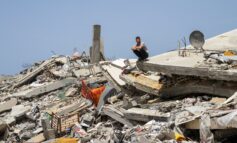Outside it was a sticky 44 degrees Celsius (111 degrees Fahrenheit), but Ali Hamdan was shivering under two parkas as he had a drink, surrounded by tables and chairs made of ice.
Chillout is the Middle East’s first ice lounge and the latest venture in this desert Gulf emirate that has been transformed by a mania for the biggest, first or most outlandish.
Gulf men in traditional white robes with wives covered in black cloaks, teenagers eager to experience their first cold blast and Westerners who miss the chill are flocking to the bar-restaurant to hang out in what amounts to a freezer.
Everything is made of ice: the walls, tables and chairs; cups, glasses and plates; the art on the wall, the sculptures depicting Dubai’s skyline, the beaded curtains, the 7-foot-chandelier and the bar.
 |
| Arab guests have a drink in the Chill Out ice lounge, the first to open in the Middle East, in Dubai August 13, 2007. REUTER/Ahmed Jadallah |
“It was the first time that I’ve been in such a cold place,” said Fatima Ali, a 13-year-old Emirati, as she emerged from the restaurant, still breathless from the adventure. “It was fantastic. I took pictures to show my friends so they would come too.”
Not everyone is so impressed. Some rush out after only a few minutes in the minus 6 Celsius (21 degrees Fahrenheit) temperature.
The 60-dirhams (US$17) cover charge gets you one drink and the rental of a hooded parka, woolen gloves and insulated shoes. Customers don them outside, then spend a few minutes in the Buffer Zone, a room set at 5 degrees Celsius (41 degrees Fahrenheit), to adjust before entering the restaurant.
Sami al-Muhaideb, a 25-year-old Saudi travel agent, warned his friend Yousef Badr going in to expect a blast of cold air, like a freezer. Thirty minutes later, Badr emerged shivering, with a red nose.
Hamdan, 22, who works at Dubai customs, looked miserable as he sipped hot chocolate, an extra parka covering his legs. He hadn’t quite dressed for the occasion, coming in a t-shirt and bermuda shorts.
“He’s not happy,” his colleague Marwa Kharsa, a 25-year-old from Atlanta, Georgia, said with a laugh. “But I’m extremely happy. I miss the cold.”
While the new, U.S.$3 million-hangout, which opened in a Dubai mall in June, is expected to become a must-see tourist destination, it also is expected to raise questions about already high energy consumption in this desert land.
The average person in the Emirates puts more demand on the global ecosystem than any other in the world, according to the World Wildlife Fund. In a report issued in October, the WWF said the Emirates’ ecological footprint measured 11.9 global hectares per person, compared to 9.6 hectares per person for the United States and a global average of 2.2 hectares a person. The scale measures the amount of land needed to generate resources for one person.
Energy consumption in the Emirates runs high for many reasons, particularly because of the air conditioning that cools houses, malls, cars and public places not only during the furnace-hot summers but in the warm winters.
Making matters worse are Dubai’s audacious developments. The emirate has transformed itself into a financial and tourism center, building up its name with dramatic projects — the world’s tallest skyscraper, island resorts in the shape of palm trees and maps of the world, even an indoor ski slope that still creates snow amid the inferno of summer.
Mike Ebenezer, business manager at Sharaf Group, which owns Chillout, insists it only consumes as much energy as a cold storage facility for frozen foods.
“There are hundreds of cold storages in Dubai,” said Ebenezer.
Ebenezer said Chillout is the ninth such ice bar in the world, with others in the U.S., Sweden, Australia, New Zealand, London and Italy.
“It’s a cool oasis in the middle of the desert,” said Ebenezer.
“We want it to be a fashion and lifestyle statement for the Dubai people,” he added. “It’s the kind of place where you want to be seen.”
It took 40,000 tons of ice to build the decor of the 2,400-square-foot restaurant. Every item was designed, carved and cut at a studio freezer at Iceculture Inc. in Canada and then shipped to Dubai.
Diffused lighting, from low-heat LED bulbs, constantly changes colors as it filters through the ice blocks. Sheepskin rugs cover the seats for the diners’ comfort. Cocktails — which are non-alcoholic in a nod to Muslim culture — are served in ice glasses that are later discarded.
Hot drinks and food, from an Asian fusion menu, are served in stainless steel thermos containers — but still get cold within 15 minutes, diners are warned.
Putting on their parkas, newlywed Lebanese couple Yousef and Obeida Bissani, who live in Dubai, said they are used to cold winters in Lebanon but wanted to see what it’s like to sit on an ice bench and drink from an ice glass.
“We didn’t want to go to Ski Dubai because we have (the Lebanese) ski resort of Faraya,” said Obeida Bissani, 23, who works in advertising.
Thuraya Amory, a 24-year-old Moroccan who works in sales, brought her mother, Amina, who was visiting from their homeland.
“It’s the first time that I experience cold in Dubai,” she said. “It’s nice to do it from time to time.”
An Associated Press report





Leave a Reply